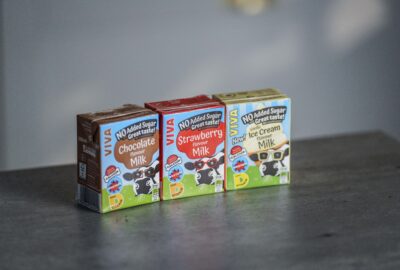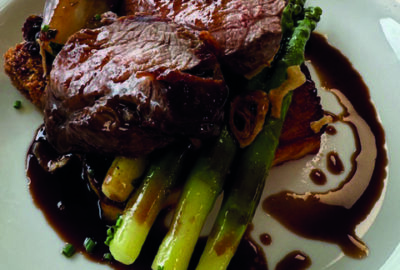Ban the bland and take higher education catering to another level
There are currently around 1.7million students in 154 learning institutions in the UK and it is estimated that students spent £5.4billion on food in 2013/14, with around a fifth of this being out-of-home consumption. A recent poll by TUCO (The University Caterers Association) revealed, reassuringly, that seven out of 10 buy food and drink from university outlets with lunch, rather obviously being the most popular day part. However, caterers working in colleges and universities face tough competition from the High Street in their bid to keep students dining on-site and it is vitally important to keep in touch with what students want from their food offering. Despite the improving financial circumstances for some students, it is clear that the majority still operate on fairly tight budgets. Value for money and a need for economy are key themes in what students look for when deciding what food to buy out of home and where to buy it.
According to the YouGov survey “University Catering 2015”:
- 33% eat in the college canteen/refectory
- 37% buy snacks from campus outlets
- 12% at branded outlets on campus
- 12% don’t eat
- 52% take their own packed lunch
- 27% buy snacks from college vending machines
- 17% eat at food outlets run by the Students Union
- 15% go off campus to buy food
Reasons for food choice:
- Value for money 61%
- Healthy options 34%
- Tempting food 29%
- Quick service 34%
- Grab & go 30%
- Cheap 53%
- Nearby 41%
Freedom to choose
A significant proportion of students say they enjoy being able to choose what to eat and that they eat very differently than when in their parent’s home. However, for many, this is a slippery slope towards unhealthy eating and results in weight gain. Nevertheless, there is a strong level of interest in healthy eating among students, especially females. It is also true that many students develop an interest in healthy eating as they progress through university. “Catering in higher education is changing,” says Jill Whittaker, MD of HIT Training, the leading specialist training and apprenticeship provider for the UK’s hospitality industry. “Whilst budget still very much plays a factor in how students choose their food options, their attitude has changed; the emphasis is becoming less about the typical ‘cheap and cheerful meal’, and more about nutritious content and authenticity. “Students’ changing tastes extend further than just meals; they have also become more sophisticated when it comes to ‘on-the-go’ beverage options. A great cup of tea or coffee is simply expected from any establishment including university campuses, particularly as most students will have grown up within the current ‘café culture’ and expect high standards.” Out-of-home breakfast is often on the move According to YouGov, 72% of students eat breakfast where they live, but 22% do buy it out-of-home at least sometimes and 10% buy it on their way to college/university. When breakfast is eaten at home, cereal or toast is most likely to be on the menu but out-of-home eating is based on a wider variety of items with grab and go items being particularly popular.
Despite the popularity of packed lunches (52%), lunch is the meal occasion with the highest proportion of out-of-home purchases in colleges and universities, and the college canteen/refectory is the overall most popular venue (33%). However, there are still a significant proportion of students who buy food on the way/pop out to buy something. Sandwiches and fresh fruit are the most likely lunchtime fare, but confectionery/biscuits/snacks, pasta and salad are also very popular options. The average weekly spend on lunch out of home is £7.31, with first year undergraduates spending £7.42. Street food influences With the increase in unique food offerings and the rising popularity of street food and pop-ups, there is a great opportunity for university caterers to add a wide variety of highly lucrative street food style dishes to their menus. Jessica Lalor, brand manager for Kerrymaid, says: “Ethnic influences will begin making an appearance on menus, as well as smoked flavours such as rich BBQ, which will remain on trend. Hot and spicy seasonings will come into their own with sriracha (chilli peppers, garlic, sugar and salt) and harrissa (roasted red peppers, fresh coriander, caraway seeds and garlic) pastes meeting demand for spicy seasoned burgers.” Exotic flavour combinations such as Banh Mi – a juicy and exotic Vietnamese-inspired bread using ginger, coriander, lime, pepper and umami – and Kimchi – a Korean dish which includes soy sauce, ginger, garlic and sesame – are also expected to be popular on the high street menus. “University caterers can replicate these flavour trends in order to meet the demands of students and create unique and distinctive menus for students,” adds Jessica.
Be saucy
Once you’ve identified the key trends on the High Street, the next step is to find professional food solutions that meet the student budget. Clever usage of ready-to-use sauces is a simple and affordable way to achieve this, says John Glover, sales director of Rich Sauces. “You’ve got to take the concept and bring them in-house and provide the flavours that students are looking for,” he explains. “For example, tuna mayonnaise is one of the top five sandwich choices but it sounds dull and you can buy it anywhere. By premiumising it you can entice people to try something different so why not try serving it on granary bread, which is healthier, use taco mayonnaise for a bit of heat, replace the sweetcorn with diced pepper, add some rocket and you’ve got a ‘Mexican Tuna Deli Sandwich’. Similarly, if you’re serving pasta and meatballs, why not offer a ‘Fire-roasted Meatball Sub’ too using the same ingredients? “It’s all about understanding the competition. Subway’s number one selling sauce is Southwest sauce, which is essentially chipotle mayo, whilst there is an entire generation of students who have grown up with Nando’s piri piri sauce so you need to be looking to those flavour profiles and adapting them to suit your market and budget.”
Beef brisket is a cheap cut of meat and bang on trend. Slow cook it for six to eight hours and coat in a quality ready-to-use sauce for a delicious Asian fusion dish. Pull it and serve on an onion brioche with Applewood cheese slaw for a delicious, on budget, Asian fusion inspired sandwich. Customise your coleslaw by mixing in different ready-touse sauces to add interest and flavour to your salads and sandwiches. Try sweet chilli and cranberry mayo, chipotle mayo and BBQ cheese coleslaw.
Customised burgers
Burgers are a great way for campus chefs to keep their food offering current and Kerrymaid has identified the most up-and-coming burger flavour trends for universities to keep their menus fresh and exciting, reflecting the same menu offering as the high street. To create new flavour combinations, cheese can be complemented with other toppings such as chorizo, citrus and Mediterranean spices which will be in high demand as students look for even more flexibility around burger customisation. Like burgers, pulled pork remains a firm street food favourite and Country Range Pulled Pork in Barbecue Sauce is available in an easy-to-use pouch, which can be dropped into boiling water and reheated for easy usage.
Cash in
Cashless payment technologies offer a variety of benefits which can help caterers to meet students’ changing tastes and increase their spend. Chris Lyons, MD of Systopia International, explains: “A cashless payment system can be integrated with existing student ID cards, such as NUS cards or security passes, providing a one-stop token covering security access and payment for food, beverages and other items within the education environment. “Secondly, cashless payment systems are proven to deliver a more efficient service by eliminating the time it takes to exchange money and count out change.” With the introduction of cashless payment cards, caterers can also implement loyalty schemes or run promotions to further encourage sales and drive footfall by offering students points on their cashless cards or money off selected items. In addition, caterers have instant access to extensive analytical tools which provide in-depth real-time analysis of sales data, trends and total control of article prices, all on a single, central database. “Using this information, the catering team can identify what the most popular meals are and find out which dishes are selling well amongst students. With this data, caterers can then plan their menus accordingly and order stock to accommodate for students’ changing tastes,” adds Chris


